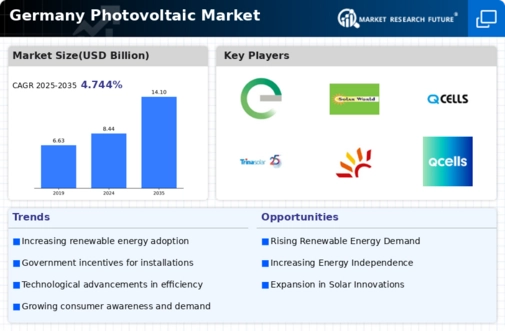The photovoltaic market in Germany is characterized by a dynamic competitive landscape, driven by a combination of technological advancements, regulatory support, and increasing demand for renewable energy solutions. Key players such as First Solar (US), JinkoSolar (CN), and Hanwha Q CELLS (KR) are strategically positioned to leverage these growth drivers. First Solar (US) focuses on innovation in thin-film technology, which enhances efficiency and reduces costs, while JinkoSolar (CN) emphasizes large-scale production capabilities and global distribution networks. Hanwha Q CELLS (KR) is known for its strong emphasis on R&D, particularly in high-efficiency solar cells, which collectively shapes a competitive environment that is increasingly focused on technological differentiation and sustainability.
In terms of business tactics, companies are localizing manufacturing to mitigate supply chain disruptions and optimize logistics. The market structure appears moderately fragmented, with several players vying for market share, yet dominated by a few key firms that exert considerable influence. This competitive structure fosters an environment where innovation and operational efficiency are paramount, as companies strive to maintain their competitive edge.
In October 2025, First Solar (US) announced a significant expansion of its manufacturing capacity in Germany, aiming to increase production of its advanced thin-film solar panels. This strategic move is likely to enhance its market presence and meet the growing demand for sustainable energy solutions in Europe. By localizing production, First Solar (US) not only reduces transportation costs but also aligns with Germany's stringent environmental regulations, positioning itself as a leader in the green energy transition.
In September 2025, JinkoSolar (CN) secured a major contract to supply solar modules for a large-scale solar farm in Germany, which is expected to generate approximately 500 MW of power. This contract underscores JinkoSolar's commitment to expanding its footprint in the European market and highlights its competitive advantage in large-scale project execution. The strategic importance of this contract lies in its potential to solidify JinkoSolar's reputation as a reliable supplier in a rapidly growing market.
In August 2025, Hanwha Q CELLS (KR) launched a new line of high-efficiency solar panels designed specifically for the European market, featuring enhanced performance in low-light conditions. This product innovation reflects the company's focus on meeting the unique needs of the German market, where energy efficiency is a critical factor. The introduction of these panels is likely to strengthen Hanwha Q CELLS' competitive position and appeal to environmentally conscious consumers.
As of November 2025, the competitive trends in the photovoltaic market are increasingly defined by digitalization, sustainability, and the integration of AI technologies. Strategic alliances among key players are shaping the landscape, fostering collaboration that enhances innovation and operational efficiency. Looking ahead, competitive differentiation is expected to evolve from traditional price-based competition to a focus on technological innovation, supply chain reliability, and sustainability initiatives. This shift indicates a growing recognition that long-term success in the photovoltaic market will hinge on the ability to deliver not only cost-effective solutions but also environmentally responsible products.

























Leave a Comment